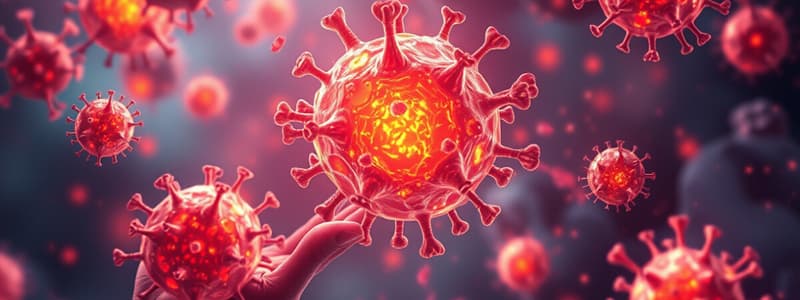Podcast
Questions and Answers
What characterizes Type I hypersensitivity reactions?
What characterizes Type I hypersensitivity reactions?
- They typically manifest with delayed symptoms over several days.
- IgG is produced in response to allergens.
- They involve cytotoxic reactions to self-antigens.
- Histamine is released due to mast cell degranulation. (correct)
Which of the following is NOT an example of an allergen that triggers Type I hypersensitivity?
Which of the following is NOT an example of an allergen that triggers Type I hypersensitivity?
- Dust mites
- Red blood cells (correct)
- Insect venom
- Shellfish
What is the main mechanism involved in Type II hypersensitivity?
What is the main mechanism involved in Type II hypersensitivity?
- Immediate release of histamines from mast cells.
- Delays based on T-cell and macrophage interactions.
- Antigen-antibody complexes depositing around blood vessels.
- Immune response targeting self-antigens. (correct)
Which condition is an example of Type III hypersensitivity?
Which condition is an example of Type III hypersensitivity?
Which type of hypersensitivity is characterized by a delayed response, typically taking 48-72 hours?
Which type of hypersensitivity is characterized by a delayed response, typically taking 48-72 hours?
Which of the following best describes Type III hypersensitivity mechanisms?
Which of the following best describes Type III hypersensitivity mechanisms?
Which of the following is a characteristic feature of Type II hypersensitivity reactions?
Which of the following is a characteristic feature of Type II hypersensitivity reactions?
What role do mast cells play in Type I hypersensitivity?
What role do mast cells play in Type I hypersensitivity?
Flashcards are hidden until you start studying
Study Notes
Hypersensitivity Overview
- Hypersensitivity refers to an exaggerated immune response to antigens leading to harmful clinical effects.
- The four types of hypersensitivity reactions can occur simultaneously, rather than in isolation.
Type I – Immediate Hypersensitivity (Atopy)
- Characterized by the production of IgE antibodies instead of IgG.
- Involves mast cell degranulation and release of histamine.
- Triggered by allergens, which are typically harmless substances that provoke allergic reactions.
- Common allergens include shellfish, pet dander, dust mites, peanuts, latex, and insect venom.
- Anaphylaxis is a severe, systemic response associated with this type.
Type II – Cytotoxic Reactions to Self-Antigens
- Involves the immune system targeting its own tissues.
- Mechanisms include complement activation, agglutination, and phagocytosis.
- Associated with conditions such as hemolytic diseases of the newborn and myasthenia gravis.
- Can involve cross-reaction between foreign substances and the body’s own tissues, exemplified by:
- Hemolytic streptococci affecting mitral valve disease.
- Guillain-Barre syndrome resulting from this reaction.
Type III – Immune Complex Diseases
- Involves the formation of antigen-antibody complexes that deposit around small blood vessels.
- Triggers a complement cascade leading to acute inflammation and tissue damage.
- Conditions associated with this type include rheumatoid arthritis, nephritis, pericarditis, and vasculitis.
- Systemic lupus erythematosus is noted for having cell nuclei as antigens, contributing to disease symptoms.
Type IV – Cell-Mediated Immunity
- Features a delayed allergic reaction typically occurring 48-72 hours after exposure.
- Primarily relies on interactions between macrophages and T-cells, which take time to develop.
- Conditions include transplant rejections and delayed contact dermatitis, such as reactions to poison ivy.
Studying That Suits You
Use AI to generate personalized quizzes and flashcards to suit your learning preferences.




